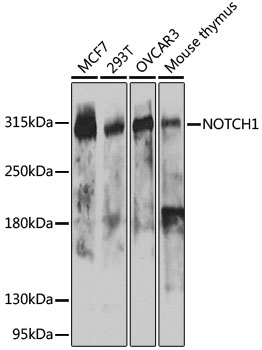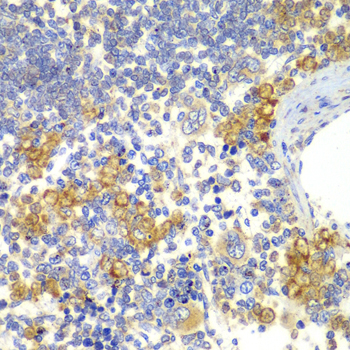Product Detail
Product NameNOTCH1 Polyclonal Antibody
Host SpeciesRabbit
ClonalityPolyclonal
IsotypeIgG
PurificationAffinity purification
ApplicationsWB,IHC,IF
Species ReactivityHuman,Mouse,Rat
Immunogen DescA synthetic peptide of human NOTCH1
ConjugateUnconjugated
Other NamesNOTCH1; AOS5; AOVD1; TAN1; hN1; notch 1
Accession NoSwiss-Prot#:P46531
NCBI Gene ID:4851
Uniprot
P46531
Gene ID
4851;
Calculated MW300kDa
FormulationAvoid freeze / thaw cycles.|Buffer: PBS with 50% glycerol, pH7.4.
StorageStore at -20˚C
Application Details
WB 1:500 - 1:2000
IHC 1:100 - 1:200
IF 1:50 - 1:200
Western blot analysis of extracts from normal (control) and NOTCH1 knockout (KO) HeLa cells, using NOTCH1 at 1:500 dilution.
Western blot analysis of extracts of various cell lines, using NOTCH1 at 1:1000 dilution.
Immunohistochemistry of paraffin-embedded rat spleen using NOTCH1 at dilution of 1:100 (40x lens).
Immunofluorescence analysis of U2OS cells using NOTCH1 at dilution of 1:100. Blue: DAPI for nuclear staining.
This gene encodes a member of the NOTCH family of proteins. Members of this Type I transmembrane protein family share structural characteristics including an extracellular domain consisting of multiple epidermal growth factor-like (EGF) repeats, and an intracellular domain consisting of multiple different domain types. Notch signaling is an evolutionarily conserved intercellular signaling pathway that regulates interactions between physically adjacent cells through binding of Notch family receptors to their cognate ligands. The encoded preproprotein is proteolytically processed in the trans-Golgi network to generate two polypeptide chains that heterodimerize to form the mature cell-surface receptor. This receptor plays a role in the development of numerous cell and tissue types. Mutations in this gene are associated with aortic valve disease, Adams-Oliver syndrome, T-cell acute lymphoblastic leukemia, chronic lymphocytic leukemia, and head and neck squamous cell carcinoma.
If you have published an article using product 30991, please notify us so that we can cite your literature.
et al,DLX5 promotes osteosarcoma progression via activation of the NOTCH signaling pathway. In Am J Cancer Res on 2021 Jun 15 by Xiaojing Zhang, Huiqin Bian, et al..PMID:34249467
, (2021),
PMID:
34249467
et al,Clostridium butyricum ameliorates indomethacin-induced enteropathy by promoting MUC2 secretion via suppressing the Notch pathway.
, (2025),
PMID:
40177488
et al,Clostridium butyricum ameliorates indomethacin-induced enteropathy by promoting MUC2 secretion via suppressing the Notch pathway.
, (2025),
PMID:
40177488






 Yes
Yes



